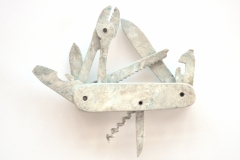Because we all might enjoy coming out for an evening of art and wine right about now, and because we are, after everything, thrilled to be exhibiting this fantastic show, Auxiliary Projects will open our first exhibition, The Gospel of Skills, a solo exhibition of work by James Huang this Friday, November 9th. There will be an opening reception at the gallery Friday, November 9th, from 7-9pm, and the exhibition will run through December 16th.
James Huang has been exploring the skills, materials, and conceptual implications of sculpture for two decades. He is devoted to solitary, arduous hand-crafting of materials at a time when much of contemporary sculpture is gleefully or thoughtlessly outsourced, either to local studio assistants or to far-flung repositories of even cheaper labor.
In the tiny gallery, Huang will exhibit several sculptures. His trio of cast plaster objects, The Golden Age of Plaster (2009), consists of three common objects found in the sculptor’s studio: a chainsaw, a dolly, and a coffee maker. To make these three works, Huang hand-formed multiple molds in deep sand, digging out the negative space of each object from memory, and pouring plaster into the sand molds to create each sculpture. He allowed each sculpture one found object embellishment: the blade of the saw, the carafe of the coffee maker, and one caster of the dolly are “real.” The plaster sculptures, meanwhile, are still covered in sand embedded during the casting process.
In Dialogue of the Demiurge (2012), Huang continues an ongoing aesthetic exploration of origin mythologies and foundational texts. As a sculptor, Huang is drawn to stories of an earth that is formed, rather than spoken, into being. Dialogue of the Demiurge can be seen as a design-aid for a god-sculptor. We are accustomed to oral or written testimony. But perhaps sculpture as well can be instructional.
Huang renounces purity; his work introduces the viewer to the qualities of sculptural materials not through formalist strategies of reduction but rather through a baroque scrambling of form, function and metaphor. He puts great faith in the viewer. He is confident that we will know what his surfaces are, where they are generally found, and what their native associations may be; he trusts us to overlay those meanings onto his reimagined, speculative use.
For this exhibition at Auxiliary Projects, Huang has produced The Gospel of Skills (2012), a series of 36 unique handmade interpretations of Swiss Army knives, each hand-crafted in one of four different sculpture materials (plaster, Plexiglas, metal, and wood) after nine original Swiss Army designs. For these, James adopts their original disturbing nomenclature such as “Executive,” “Hunter,” and (curiously) “Manager.” In the ordinary life most city dwellers enjoy most of the time, utility knives may be used to open a beer or cut off a plastic sales tag. How much less useful is a felt knife? Or as the designer Charles Eames asked in 1972, “Who would say that pleasure is not useful?”





